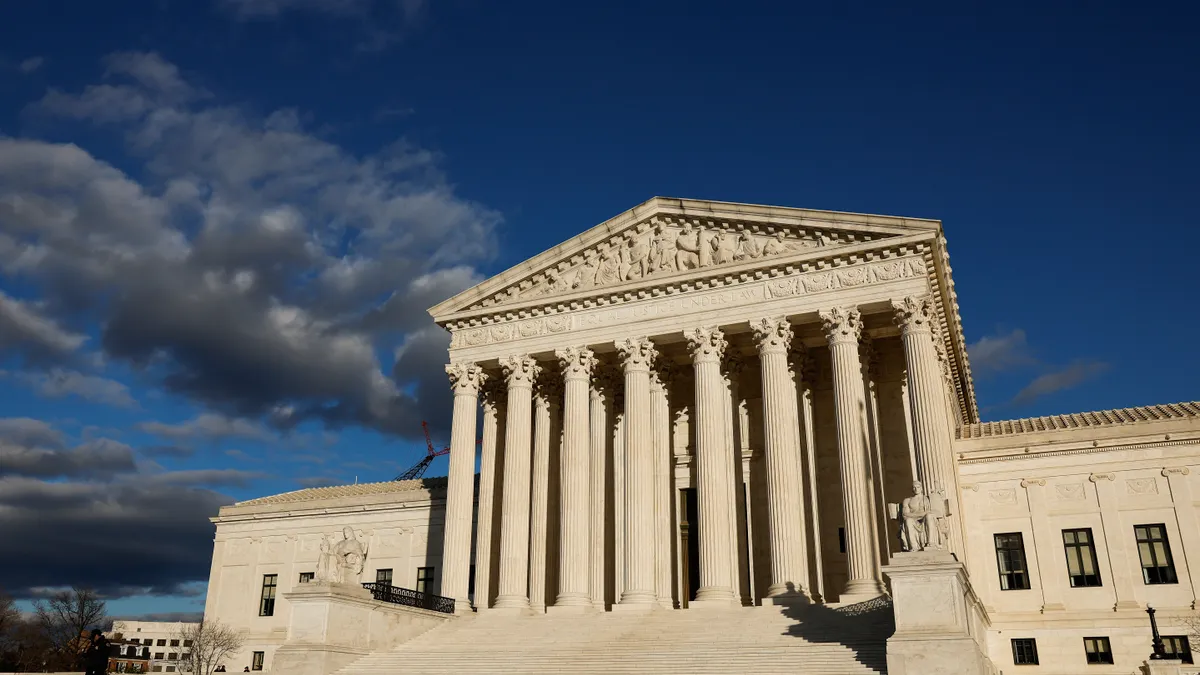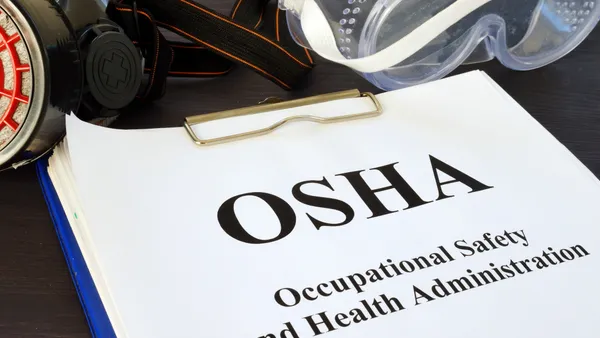The Supreme Court’s June Chevron ruling will likely have a seismic impact on laws that pertain to the construction industry, legal experts say.
In their Loper Bright Enterprises v. Raimondo decision this summer, the justices struck down the 1984 decision in Chevron v. Natural Resources Defense Council — previously one of the most consequential rulings on federal administrative law. The decision rolled back the power of federal agencies to interpret the laws they administer, and ruled instead that courts should interpret ambiguities.
Now, with the fall of what was known as the Chevron deference doctrine, a slew of regulations are ripe for challenges on the grounds that the federal agencies enforcing them have overstepped their bounds, legal experts told Construction Dive. The National Environmental Policy Act, Endangered Species Act and OSHA’s heat standard are among those likely to be challenged.
“In the immediate future, we're going to see an increase in litigation on this basis, and we're already seeing a lot of complaints being amended to include Loper Bright in cases that are before the courts now,” said attorney Prianka Sharma, vice president and counsel for regulatory affairs for the American Road & Transportation Builders Association.

In theory, the decision should result in less vacillation in regulations when presidential administrations change. However, the changes will take time to shake out, which could delay permitting as agencies try to understand how they must adapt. There will continue to be uncertainty until some legal precedent is established at the federal district court and circuit court levels, according to Sharma.
“One thing that we're really hoping for is that [Loper Bright] will lead to less pendulum swinging depending on who's in office,” Sharma said.
A second ruling
Just days after Loper Bright, the Supreme Court ruled in Corner Post v. Board of Governors of the Federal Reserve System that the six-year window to challenge an agency regulation starts when a plaintiff is injured by the rule, rather than when the regulation was finalized. In other words, builders that are newly impacted by longstanding regulations may now have the chance to challenge them.
Together, these rulings open up established rules to new scrutiny, and this time, agencies will not receive the same deference they had under Chevron. That likely means the construction industry will dispute laws they previously thought weren’t worth the effort, said attorney Curtis Moore, partner at Atlanta-based Fisher Phillips.

“If an employer has a disagreement with the agency over an interpretation, in the past, we might say, ‘Well, this is a pretty uphill battle, given that the agency gets deference to its interpretation.’ Now there really isn't that thumb on the scale, so to speak,” Moore said.
Legal changes post-Chevron
Congress will likely pass more detailed laws going forward as a result of Loper Bright, according to attorney Rafe Petersen, partner at Miami-based Holland & Knight and member of the firm’s Chevron Deference Working Team.
When new administrations come in, they typically want to undo the work of the previous administration, but now, rather than new agency appointees interpreting laws differently, Congress must amend those laws in order to advance a new agenda.
“It used to be the Congress, I think, felt like they were doing a favor by drafting a relatively vague law that would give the agency wiggle room,” Petersen said. “Now with the current jurisprudence … unless there's a real clear statement and Congress wanted the agencies to do it, the courts are going to say, ‘Well, no, you don't have authority, go back to Congress if you want that fixed.’”
That said, agencies will also be preparing for a post-Chevron landscape, according to Sharma, “so they will be trying to bolster their arguments too.”
One unintended consequence of Loper Bright is that agencies may rely more on recommendations rather than regulations, which would be more difficult to challenge, Petersen said.
“An ironic effect may be that agencies now regulate more through guidance again,” Petersen said. “If they're afraid the regulation is going to get struck, then they'll use guidance, which is harder to challenge, because they'll say, ‘Well, that's not binding as a matter of law.’”
Laws vulnerable to challenge
The Loper Bright decision will likely come into play most in cases where an administration is seeking to advance an agenda, and the underlying laws are not very clear, said Petersen.
In particular, he expects regulations based on more modern concepts of environmental law and environmental justice to be challenged, such as those dealing with stormwater, the National Environmental Policy Act and the Endangered Species Act.
“The Clean Air Act and the Clean Water Act and all these laws, a lot of these were written in the ‘70s. Well, nobody contemplated, much less put into the law, things such as, ‘How do you address climate change and how do you address environmental justice?’” Petersen said.
Some OSHA regulations, like a pending heat standard, may also be vulnerable because the agency tends to interpret its powers broadly, according to Moore. Also up for legal challenge is its position that the agency can record interviews without permission of the employee or management official, which contradicts an earlier interpretation from the ‘90s.
For builders in warmer parts of the country, “[the heat standard is] almost always going to be triggered, and it's going to have a big impact on how you can schedule your work to be performed,” Moore said. “I think those are the types of regulations where industry groups and employers are going to decide it's worth the legal expense to challenge this in light of Chevron.”
In addition, multifamily builders may challenge how the Fair Housing Act’s design and construction rules have been interpreted, as well as HUD’s new floodplain rules, Petersen said.
“For multifamily companies that are constructing multifamily housing, etc., I would think that would be something that would be at least looked into,” Petersen said.

Two challenges that have already been filed and may include a Loper Bright argument are to the Federal Highway Administration’s greenhouse gas rule and to OSHA’s walkaround rule, said Sharma. Petersen expects more Loper Bright-related cases to start trickling out in the next month or two.
Other laws have less chance of being successfully overturned.
“I would think that in most of those cases where there was a previous Chevron challenge to the statute, that decision is going to stand unless there's a new ground brought up,” Moore said. “I think this is going to operate more prospectively, where you see new regulations or new statute challenges be decided post-Chevron.”
What builders should know
As cases work their way through the court system, varied rulings from different circuits could make it complicated for builders to understand how they should comply. The Supreme Court may be called upon more frequently to decide on disagreements at the circuit court level.
Until the Supreme Court establishes some precedent, “I think you will see inconsistent decisions, probably, from different circuits, and that will at least initially create a little bit of a headache for employers as they try to figure out, you know, ‘OK, if I operate in multiple states and one decision went this way and another decision went that way, what do I do?’” Moore said.
For now, industry pros must be ready for compliance, according to Moore.
“If you're in an industry that will be impacted by the heat stress rule or any other rules that are coming out, be prepared for those,” Moore said. “So start looking at implementing policies and procedures that you may have to have if those rules do go into effect and challenges aren't successful.”
In the near term, the ruling could slow down permitting, according to Petersen.
“That is usually what causes agencies to delay, is they have to deal with the newest case and deal with the newest guidance and work through what happens when their regs get struck. So, you know, agencies such as the Army Corps of Engineers and EPA, you know, this could well have the effect of slowing down permits,” Petersen said.
To deal with this, Petersen urged builders to apply for permits as early as possible and to use them as soon as they’re obtained.
“When there's all this rapid change and things getting overturned, I always advise people that, even if the build-out is in phases, use the permit,” Petersen said. “Go quickly, if you can, in times of uncertainty, just to make sure you get the benefit of all your hard work.”














